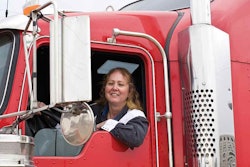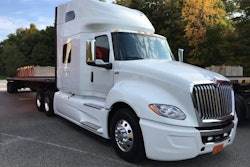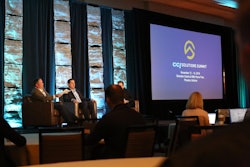 Keith Mader, Trimble Transportation’s vice president of data analytics, announced the new Dispatch Advisor tool at the in.sight user conference, Sept. 16
Keith Mader, Trimble Transportation’s vice president of data analytics, announced the new Dispatch Advisor tool at the in.sight user conference, Sept. 16Several months ago, leadership of Trimble Transportation set a goal to have a new optimization tool ready to announce at the company’s annual in.sight conference in Houston, Sept. 15-18.
At last year’s event, Keith Mader, vice president of analytics, hinted at the possibility during an interview with CCJ, but made it official on stage by launching the Trimble Dispatch Advisor on Sept. 16.
The new product gives fleet customers that use the Trimble enterprise transportation management software (TMS) platforms TMW Suite, TruckMate or Innovative a way to instantly see the best options for matching their loads with trucks.
After the opening session, Mader and Chris Orban, vice president of data science, met with CCJ to explain the new product.
Trimble Dispatch Advisor succeeds IDSC Match Advice, an application that TMW Systems acquired in 2007 with the purchase of IDSC. Trimble later acquired TMW Systems in 2012, the year after it purchased fleet mobility provider PeopleNet.
The first version of Dispatch Advisor optimally matches loads with a single origin and destination to power units (a tractor with one or more drivers), said Orban. IDSC Match Advice does the same thing, but the latest product has a new algorithm and workflow process to help load planners account for human elements in their decisions, they explained.
The algorithm finds the minimum-cost combination of loads and trucks. It does this using a cost matrix of time, distance, deadhead miles and other variables, Orban said, where “cost” is not necessarily a dollar value. A load that gets a driver home for the weekend, for example, may have a lower cost value than a load that does not.
Orban described the optimal path through this cost matrix as a “diagonal” that connects the loads with the power units that deliver the lowest possible cost for the system. The optimal recommendations for loads and tractors are fed directly into the load planning screens of the TMS systems. Users also get recommendations for the second, third, and forth-best options (and more) with scores that show the reasons why.
 Thomas Fansler, chief technology and data officer of Trimble, mentioned the Dispatch Advisor as an example of how the company is developing products across its business units.
Thomas Fansler, chief technology and data officer of Trimble, mentioned the Dispatch Advisor as an example of how the company is developing products across its business units.By showing the next-best recommendations, users can account for human factors. A load planner may choose to go with the optimal solution for the easiest choices and use the recommendations to simplify the more complex decisions.
“We order [the recommendations], so we show them which one we would like them to pick but we also have all the other options right below it,” Mader said.
Choosing a sub-optimal recommendation is often necessary to “help or address how you treat drivers,” Mader said, since drivers have individual load and route preferences, for example, that the model can take into consideration.
Trimble Dispatch Advisor is currently in the beta process and is being used by a number of early adopter fleets within their planning process. To use the new product, Trimble customers need to have a modern version of TMS and pay for a license. Installation takes as little as one hour to have automated load planning recommendations, Orban said.
“It has really been a team effort to get some of this going. It has not been easy, but I think customers are going to see the results,” he said.
Trimble has integrated another data science product in the load planning process that predicts which drivers are most likely to quit. The model uses hours-of-service and other operational data to make the predictions.
Users have a web-based portal for visibility to predictive driver retention scores. This information is also visible within Trimble’s TMS systems to give load planners information to use when making driver decisions, Mader said.
A load planner can see which drivers are most likely to quit and why. An at-risk driver may have low miles, for example, and with this information a planner could make a better dispatch decision. Notes from driver interactions are displayed in the load planning screen as well. If a planner is about to assign a load to a driver with lower mileage, the planner could contact the driver to explain the situation and promise to get the driver a higher-mileage load on the return trip, Orban said.
With the latest developments, Trimble has a long ways to go before artificial intelligence is ready to replace humans in the office for matching freight, both Mader and Orban emphasized.
“This is a recommendation engine. This is not automated dispatch,” Orban said. “This is not ‘hey, we know everything there is to know and we’re just going to tell you what to do.’”












